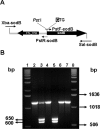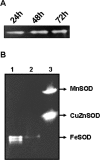Superoxide dismutase B gene (sodB)-deficient mutants of Francisella tularensis demonstrate hypersensitivity to oxidative stress and attenuated virulence
- PMID: 16923916
- PMCID: PMC1595384
- DOI: 10.1128/JB.00266-06
Superoxide dismutase B gene (sodB)-deficient mutants of Francisella tularensis demonstrate hypersensitivity to oxidative stress and attenuated virulence
Abstract
A Francisella tularensis live vaccine strain mutant (sodB(Ft)) with reduced Fe-superoxide dismutase gene expression was generated and found to exhibit decreased sodB activity and increased sensitivity to redox cycling compounds compared to wild-type bacteria. The sodB(Ft) mutant also was significantly attenuated for virulence in mice. Thus, this study has identified sodB as an important F. tularensis virulence factor.
Figures





References
-
- Anthony, L. S. D., P. J. Morrissey, and F. E. Nano. 1992. Growth inhibition of Francisella tularensis live vaccine strain by IFN-gamma-activated macrophages is mediated by reactive nitrogen intermediates derived from l-arginine metabolism. J. Immunol. 148:1829-1834. - PubMed
-
- Battistoni, A., F. Pacello, S. Folcarelli, M. Ajello, G. Donnarumma, R. Greco, M. Grazia Ammendolia, D. Touati, G. Rotilio, and P. Valenti. 2000. Increased expression of periplasmic Cu,Zn superoxide dismutase enhances survival of Escherichia coli invasive strains within nonphagocytic cells. Infect. Immun. 68:30-37. - PMC - PubMed
-
- Beauchamp, C., and I. Fridovich. 1971. Superoxide dismutase: improved assays and an assay applicable to acrylamide gels. Anal. Biochem. 44:276-287. - PubMed
Publication types
MeSH terms
Substances
Grants and funding
LinkOut - more resources
Full Text Sources
Other Literature Sources

